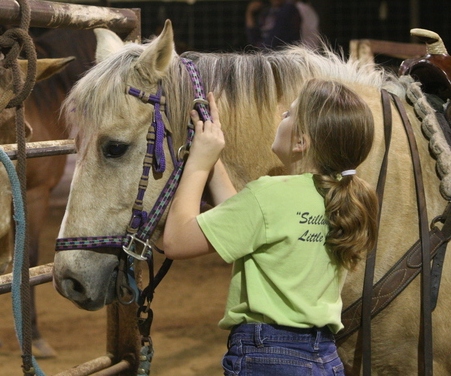 |
Quick Search |
 |
|
|
|
|
|
| Kids and Horses: Safety Tips for Beginner Riders |

|
For those of us who had the opportunity to grow up around horses, responsibilities
and safe horse-handling practices became lifelong habits. But there are a lot of
families with children who are starting from scratch, buying their first horse,
and have no idea how to go about handling one. Here are some basic guidelines
that kids and beginners should know about horses....and if they're all old-hat
to you, pass them on to a friend who might benefit from them.
1. Horses cannot see directly behind them or right in front of their nose.
Approach a horse from the side and pet his shoulder first, and always speak and
lay your hand on his hip if you must walk behind him. The horse should know where
you are at all times, so if you move, speak in a quiet voice to let him know where
you're at. Even the most gentle and best trained horse will still kick or run if
startled, so never surprise a horse.
2. When leading a horse, always stand on its left side and keep your right hand
on the lead rope under the horse's chin to control it. The horse could step on
you if it is allowed to move freely. The end of the lead rope should be folded
accordion-style and held in your left hand. Never loop a rope around your arm,
wrist, or hand.
3. Know how to tie a horse safely. You can view step by step photos
and instructions for tying a quick-release knot here at Liverystable.net--find the
article titled "How To Tie A Quick-Release Knot" in the More Horse Articles section of
the Round Pen. Make sure that the horse is tied
high enough that he cannot get a leg over the rope if he lowers his head. About two
feet of rope between the knot and the horse's halter is correct; anything longer
can be really dangerous. Never walk under or step over the rope of a tied horse.
Don't tie a horse with a long rope to allow him to graze. Ropes can easily injure
a horse's legs, and bad accidents have happened because of tying a horse the wrong
way.
4. Never attempt to help a horse that is panicked. If a horse is in trouble and
thrashing about, wait until he calms down and stands still before you try to help him.
Again, even the most gentle horse can cause deadly injuries because of his sheer
weight and power...so wait until it is safe to untie or untangle a horse that is
in trouble.
5. In the movies, the cowboy always swings down from a horse by leaving his left
foot in the stirrup and swooping his right leg over the horse's back and to the
ground. This looks fancy, but what if the horse spooks when the rider is standing
with one foot on the ground and one foot still in the stirrup? It's always safer
to remove both feet from the stirrups, lean forward in the saddle to rest on your
stomach, and swing your right leg over and drop both feet to the ground.
6. Wear appropriate clothing, footwear, and headgear around horses. If you wear
shorts and sandals, be prepared for scratches, bruises, and saddle sores!
Boots with a heel are best for riding, to keep your foot from slipping through
the stirrup; if you fall and your foot is caught, you could be kicked in the head
or drug underneath your horse. Helmets are always a good idea, because head
injuries are so serious and you never know what may happen. Enjoy your horses,
but practice these safety tips until they become habits.
More Horse Articles
|
|
|

